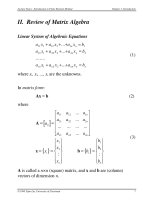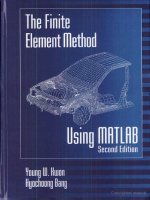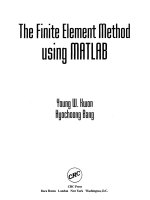Lecture Notes: Introduction to the Finite Element Method
Bạn đang xem bản rút gọn của tài liệu. Xem và tải ngay bản đầy đủ của tài liệu tại đây (1.63 MB, 188 trang )
Lecture Notes: Introduction to the Finite Element Method
Lecture Notes: Introduction to the
Yijun Liu
CAE Research Laboratory
Mechanical Engineering Department
University of Cincinnati
Cincinnati, OH 45221-0072, U.S.A.
E-mail:
Web:
/>
This document is downloaded from the course website:
/>(Last Updated: May 21, 2003)
© 1997-2003 by Yijun Liu, University of Cincinnati.
© 1997-2003 Yijun Liu, University of Cincinnati
i
Lecture Notes: Introduction to the Finite Element Method
Copyright Notice
© 1997-2003 by Yijun Liu, University of Cincinnati.
All rights reserved. Permissions are granted for personal
and educational uses only. Any other uses of these lecture
notes (such as for classroom lectures outside the University
of Cincinnati, trainings elsewhere, and those of a
commercial nature) are not permitted, unless such uses
have been granted in writing by the author.
© 1997-2003 Yijun Liu, University of Cincinnati
ii
Lecture Notes: Introduction to the Finite Element Method
Table of Contents
Copyright Notice ....................................................................................................... ii
Table of Contents ..................................................................................................... iii
Preface .......................................................................................................................v
Chapter 1. Introduction ............................................................................................1
I. Basic Concepts ...................................................................................................1
II. Review of Matrix Algebra .................................................................................7
III. Spring Element ..............................................................................................14
Chapter 2. Bar and Beam Elements.......................................................................25
I. Linear Static Analysis .......................................................................................25
II. Bar Element .....................................................................................................26
III. Beam Element .................................................................................................53
Chapter 3. Two-Dimensional Problems ................................................................75
I. Review of the Basic Theory ...............................................................................75
II. Finite Elements for 2-D Problems ..................................................................82
Chapter 4. Finite Element Modeling and Solution Techniques........................... 105
I. Symmetry ........................................................................................................ 105
II. Substructures (Superelements) ..................................................................... 107
III. Equation Solving......................................................................................... 109
IV. Nature of Finite Element Solutions ............................................................. 112
V. Numerical Error............................................................................................ 114
© 1997-2003 Yijun Liu, University of Cincinnati
iii
Lecture Notes: Introduction to the Finite Element Method
VI. Convergence of FE Solutions ...................................................................... 116
VII. Adaptivity (h-, p-, and hp-Methods) ........................................................... 117
Chapter 5. Plate and Shell Elements ................................................................... 119
I. Plate Theory ................................................................................................... 119
II. Plate Elements ............................................................................................. 129
III. Shells and Shell Elements........................................................................... 133
Chapter 6. Solid Elements for 3-D Problems ..................................................... 138
I. 3-D Elasticity Theory ..................................................................................... 138
II. Finite Element Formulation.......................................................................... 142
III. Typical 3-D Solid Elements ......................................................................... 144
Chapter 7. Structural Vibration and Dynamics................................................... 157
I. Basic Equations.............................................................................................. 157
II. Free Vibration............................................................................................... 163
III. Damping ...................................................................................................... 167
IV. Modal Equations.......................................................................................... 168
V. Frequency Response Analysis....................................................................... 171
VI. Transient Response Analysis ....................................................................... 172
Chapter 8. Thermal Analysis ............................................................................... 177
I. Temperature Field.......................................................................................... 177
II. Thermal Stress Analysis................................................................................ 180
Further Reading.................................................................................................... 183
© 1997-2003 Yijun Liu, University of Cincinnati
iv
Lecture Notes: Introduction to the Finite Element Method
Preface
These online lecture notes (in the form of an e-book) are intended to serve as
an introduction to the finite element method (FEM) for undergraduate students or
other readers who have no previous experience with this computational method.
The notes cover the basic concepts in the FEM using the simplest mechanics
problems as examples, and lead to the discussions and applications of the 1-D bar
and beam, 2-D plane and 3-D solid elements in the analyses of structural stresses,
vibrations and dynamics. The proper usage of the FEM, as a popular numerical
tool in engineering, is emphasized throughout the notes.
This online document is based on the lecture notes developed by the author
since 1997 for the undergraduate course on the FEM in the mechanical engineering
department at the University of Cincinnati. Since this is an e-book, the author
suggests that the readers keep it that way and view it either online or offline on
his/her computer. The contents and styles of these notes will definitely change
from time to time, and therefore hard copies may become obsolete immediately
after they are printed. Readers are welcome to contact the author for any
suggestions on improving this e-book and to report any mistakes in the
presentations of the subjects or typographical errors. The ultimate goal of this ebook on the FEM is to make it readily available for students, researchers and
engineers, worldwide, to help them learn subjects in the FEM and eventually solve
their own design and analysis problems using the FEM.
The author thanks his former undergraduate and graduate students for their
suggestions on the earlier versions of these lecture notes and for their contributions
to many of the examples used in the current version of the notes.
Yijun Liu
Cincinnati, Ohio, USA
December 2002
© 1997-2003 Yijun Liu, University of Cincinnati
v
Lecture Notes: Introduction to Finite Element Method
Chapter 1. Introduction
Chapter 1. Introduction
I. Basic Concepts
The finite element method (FEM), or finite element analysis
(FEA), is based on the idea of building a complicated object with
simple blocks, or, dividing a complicated object into small and
manageable pieces. Application of this simple idea can be found
everywhere in everyday life, as well as in engineering.
Examples:
• Lego (kids’ play)
• Buildings
• Approximation of the area of a circle:
“Element” Si
θi
R
1
2
Area of one triangle: S i = 2 R sin θ i
N
1
2π
2
2
Area of the circle: S N = ∑ Si = 2 R N sin N → π R as N → ∞
i =1
where N = total number of triangles (elements).
Observation: Complicated or smooth objects can be
represented by geometrically simple pieces (elements).
© 1997-2003 Yijun Liu, University of Cincinnati
1
Lecture Notes: Introduction to Finite Element Method
Chapter 1. Introduction
Why Finite Element Method?
• Design analysis: hand calculations, experiments, and
computer simulations
• FEM/FEA is the most widely applied computer simulation
method in engineering
• Closely integrated with CAD/CAM applications
• ...
Applications of FEM in Engineering
• Mechanical/Aerospace/Civil/Automobile Engineering
• Structure analysis (static/dynamic, linear/nonlinear)
• Thermal/fluid flows
• Electromagnetics
• Geomechanics
• Biomechanics
• ...
Modeling of gear coupling
Examples:
...
© 1997-2003 Yijun Liu, University of Cincinnati
2
Lecture Notes: Introduction to Finite Element Method
Chapter 1. Introduction
A Brief History of the FEM
• 1943 ----- Courant (Variational methods)
• 1956 ----- Turner, Clough, Martin and Topp (Stiffness)
• 1960 ----- Clough (“Finite Element”, plane problems)
• 1970s ----- Applications on mainframe computers
• 1980s ----- Microcomputers, pre- and postprocessors
• 1990s ----- Analysis of large structural systems
Can Drop Test (Click for more information and an animation)
© 1997-2003 Yijun Liu, University of Cincinnati
3
Lecture Notes: Introduction to Finite Element Method
Chapter 1. Introduction
FEM in Structural Analysis (The Procedure)
• Divide structure into pieces (elements with nodes)
• Describe the behavior of the physical quantities on each
element
• Connect (assemble) the elements at the nodes to form an
approximate system of equations for the whole structure
• Solve the system of equations involving unknown
quantities at the nodes (e.g., displacements)
• Calculate desired quantities (e.g., strains and stresses) at
selected elements
Example:
FEM model for a gear tooth (From Cook’s book, p.2).
© 1997-2003 Yijun Liu, University of Cincinnati
4
Lecture Notes: Introduction to Finite Element Method
Chapter 1. Introduction
Computer Implementations
• Preprocessing (build FE model, loads and constraints)
• FEA solver (assemble and solve the system of equations)
• Postprocessing (sort and display the results)
Available Commercial FEM Software Packages
• ANSYS (General purpose, PC and workstations)
• SDRC/I-DEAS (Complete CAD/CAM/CAE package)
• NASTRAN (General purpose FEA on mainframes)
• ABAQUS (Nonlinear and dynamic analyses)
• COSMOS (General purpose FEA)
• ALGOR (PC and workstations)
• PATRAN (Pre/Post Processor)
• HyperMesh (Pre/Post Processor)
• Dyna-3D (Crash/impact analysis)
• ...
A Link to CAE Software and Companies
© 1997-2003 Yijun Liu, University of Cincinnati
5
Lecture Notes: Introduction to Finite Element Method
Chapter 1. Introduction
Objectives of This FEM Course
• Understand the fundamental ideas of the FEM
• Know the behavior and usage of each type of elements
covered in this course
• Be able to prepare a suitable FE model for given problems
• Can interpret and evaluate the quality of the results (know
the physics of the problems)
• Be aware of the limitations of the FEM (don’t misuse the
FEM - a numerical tool)
FEA of an Unloader Trolley (Click for more info)
By Jeff Badertscher (ME Class of 2001, UC)
See more examples in:
Showcase: Finite Element Analysis in Actions
© 1997-2003 Yijun Liu, University of Cincinnati
6
Lecture Notes: Introduction to Finite Element Method
Chapter 1. Introduction
II. Review of Matrix Algebra
Linear System of Algebraic Equations
a 11 x1 + a 12 x 2 +...+ a 1n x n = b1
a 21 x1 + a 22 x 2 +...+ a 2 n x n = b2
.......
a n1 x1 + a n 2 x 2 +...+ a nn x n = bn
(1)
where x1, x2, ..., xn are the unknowns.
In matrix form:
Ax = b
(2)
where
a11
a
21
A = aij =
...
a
n1
x1
x
2
x = { xi } =
:
xn
a12
a22
...
[ ]
an 2
... a1n
... a2 n
... ...
... ann
b1
b
2
b = {bi } =
:
bn
(3)
A is called a n×n (square) matrix, and x and b are (column)
vectors of dimension n.
© 1997-2003 Yijun Liu, University of Cincinnati
7
Lecture Notes: Introduction to Finite Element Method
Chapter 1. Introduction
Row and Column Vectors
v = [ v1
w1
w = w2
w
3
v3 ]
v2
Matrix Addition and Subtraction
For two matrices A and B, both of the same size (m×n), the
addition and subtraction are defined by
C= A+B
with
cij = aij + bij
D = A−B
with
d ij = a ij − bij
Scalar Multiplication
λA = [λa ij ]
Matrix Multiplication
For two matrices A (of size l×m) and B (of size m×n), the
product of AB is defined by
C = AB
m
with cij = ∑ aik bkj
k =1
where i = 1, 2, ..., l; j = 1, 2, ..., n.
Note that, in general, AB ≠ BA , but ( AB )C = A ( BC)
(associative).
© 1997-2003 Yijun Liu, University of Cincinnati
8
Lecture Notes: Introduction to Finite Element Method
Chapter 1. Introduction
Transpose of a Matrix
If A = [aij], then the transpose of A is
[ ]
A T = a ji
Notice that ( AB ) T = B T A T .
Symmetric Matrix
A square (n×n) matrix A is called symmetric, if
A = AT
Unit (Identity) Matrix
1 0
0 1
I=
... ...
0 0
or
a ij = a ji
... 0
... 0
... ...
... 1
Note that AI = A, Ix = x.
Determinant of a Matrix
The determinant of square matrix A is a scalar number
denoted by det A or |A|. For 2×2 and 3×3 matrices, their
determinants are given by
a b
det
= ad − bc
c d
and
© 1997-2003 Yijun Liu, University of Cincinnati
9
Lecture Notes: Introduction to Finite Element Method
a11 a12
det a21 a22
a31 a32
Chapter 1. Introduction
a13
a23 = a11a22 a33 + a12 a23a31 + a21a32 a13
a33
− a13a22 a31 − a12a21a33 − a23a32 a11
Singular Matrix
A square matrix A is singular if det A = 0, which indicates
problems in the systems (nonunique solutions, degeneracy, etc.)
Matrix Inversion
For a square and nonsingular matrix A ( det A ≠ 0 ), its
inverse A-1 is constructed in such a way that
AA −1 = A −1 A = I
The cofactor matrix C of matrix A is defined by
Cij = ( −1)i + j Mij
where Mij is the determinant of the smaller matrix obtained by
eliminating the ith row and jth column of A.
Thus, the inverse of A can be determined by
A −1 =
1
CT
det A
We can show that ( AB ) −1 = B −1A −1 .
© 1997-2003 Yijun Liu, University of Cincinnati
10
Lecture Notes: Introduction to Finite Element Method
Chapter 1. Introduction
Examples:
a b
(1)
c d
−1
=
1
d − b
(ad − bc) − c a
Checking,
−1
1
a b a b
d − b a b 1 0
=
c d c d (ad − bc) − c a c d = 0 1
1 −1 0
(2) − 1 2 − 1
0 − 1 2
−1
T
3 2 1
3 2 1
1
2 2 1 = 2 2 1
=
(4 − 2 − 1)
1 1 1
1 1 1
Checking,
1 − 1 0 3 2 1 1 0 0
− 1 2 − 1 2 2 1 = 0 1 0
0 − 1 2 1 1 1 0 0 1
If det A = 0 (i.e., A is singular), then A-1 does not exist!
The solution of the linear system of equations (Eq.(1)) can be
expressed as (assuming the coefficient matrix A is nonsingular)
x = A −1b
Thus, the main task in solving a linear system of equations is to
found the inverse of the coefficient matrix.
© 1997-2003 Yijun Liu, University of Cincinnati
11
Lecture Notes: Introduction to Finite Element Method
Chapter 1. Introduction
Solution Techniques for Linear Systems of Equations
• Gauss elimination methods
• Iterative methods
Positive Definite Matrix
A square (n×n) matrix A is said to be positive definite, if for
all nonzero vector x of dimension n,
x T Ax > 0
Note that positive definite matrices are nonsingular.
Differentiation and Integration of a Matrix
Let
[
]
A( t ) = a ij ( t )
then the differentiation is defined by
da (t )
d
A(t ) = ij
dt
dt
and the integration by
∫
∫
A(t )dt = aij (t )dt
© 1997-2003 Yijun Liu, University of Cincinnati
12
Lecture Notes: Introduction to Finite Element Method
Chapter 1. Introduction
Types of Finite Elements
1-D (Line) Element
(Spring, truss, beam, pipe, etc.)
2-D (Plane) Element
(Membrane, plate, shell, etc.)
3-D (Solid) Element
(3-D fields - temperature, displacement, stress, flow velocity)
© 1997-2003 Yijun Liu, University of Cincinnati
13
Lecture Notes: Introduction to Finite Element Method
Chapter 1. Introduction
III. Spring Element
“Everything important is simple.”
One Spring Element
x
i
fi
ui
j
uj
k
fj
Two nodes:
i, j
Nodal displacements:
ui, uj (in, m, mm)
Nodal forces:
fi, fj (lb, Newton)
Spring constant (stiffness):
k (lb/in, N/m, N/mm)
Spring force-displacement relationship:
F = k∆
with ∆ = u j − ui
Linear
Nonlinear
F
k
∆
k = F / ∆ (> 0) is the force needed to produce a unit stretch.
© 1997-2003 Yijun Liu, University of Cincinnati
14
Lecture Notes: Introduction to Finite Element Method
Chapter 1. Introduction
We only consider linear problems in this introductory
course.
Consider the equilibrium of forces for the spring. At node i,
we have
f i = − F = − k ( u j − ui ) = kui − ku j
and at node j,
f j = F = k ( u j − ui ) = − kui + ku j
In matrix form,
k
− k
− k ui f i
=
k u j f j
or,
ku = f
where
k = (element) stiffness matrix
u = (element nodal) displacement vector
f = (element nodal) force vector
Note that k is symmetric. Is k singular or nonsingular? That is,
can we solve the equation? If not, why?
© 1997-2003 Yijun Liu, University of Cincinnati
15









